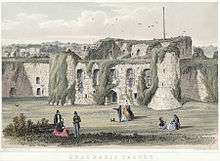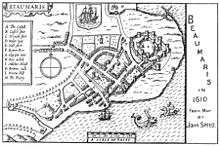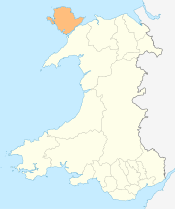Beaumaris
| Beaumaris | |
| Welsh: Biwmares | |
.jpg) Beaumaris Castle |
|
 Beaumaris |
|
| Population | 1,938 (2011) |
|---|---|
| OS grid reference | SH6076 |
| Community | Beaumaris |
| Principal area | Anglesey |
| Ceremonial county | Gwynedd |
| Country | Wales |
| Sovereign state | United Kingdom |
| Post town | BEAUMARIS |
| Postcode district | LL58 |
| Dialling code | 01248 |
| Police | North Wales |
| Fire | North Wales |
| Ambulance | Welsh |
| EU Parliament | Wales |
| UK Parliament | Ynys Môn |
| Welsh Assembly | Ynys Môn |
Coordinates: 53°16′01″N 4°05′35″W / 53.267°N 4.093°W
Beaumaris (/bjuːˈmærᵻs/; Welsh: Biwmares [bɪuˈmɑːrɛs]) is a former royal borough, a community, and the former county town of Anglesey, Wales. It was located in the commote of Dindaethwy and historic rural deanery of Tindaethwy, and is at the eastern entrance to the Menai Strait, the tidal waterway separating Anglesey from the coast of North Wales. At the 2001 census it had a population of 2,040,[1] reducing to 1,938 at the 2011 Census.[2]
History

Beaumaris was originally a Viking settlement known as Porth y Wygyr ("Port of the Vikings"),[3] but the town itself began its development in 1295 when Edward I of England, having conquered Wales, commissioned the building of Beaumaris Castle as part of a chain of fortifications around the North Wales coast (others include Conwy, Caernarfon and Harlech).
The castle was built on a marsh and that is where it found its name; the French builders called it beaux marais which translates as "beautiful marshes".

The ancient village of Llanfaes, a mile to the north of Beaumaris, had been occupied by the Anglo-Saxons in 818 but had been regained by Merfyn Frych, King of Gwynedd, and remained a vital strategic settlement. To counter further Welsh uprisings, and to ensure control of the Menai Strait, Edward I chose the flat coastal plain as the place to build Beaumaris Castle. The castle was designed by the Savoyard mason Master James of St George and is considered the most perfect example of a concentric castle. The 'troublesome' residents of Llanfaes were removed en bloc to Rhosyr in the west of Anglesey, a new settlement King Edward entitled "Newborough". French and English masons were brought in to construct the castle itself and the walled town.
Beaumaris was awarded a royal charter by Edward I, which was drawn up on similar terms to the charters of his other castle towns in North Wales and intended to invest only the English and Norman-French residents with civic rights. Native Welsh residents of Beaumaris were largely disqualified from holding any civic office, carrying any weapon, and holding assemblies; and were not allowed to purchase houses or land within the borough. The charter also specifically prohibited Jews (who had been largely expelled from most English towns) from living in Beaumaris. A requirement that all trade in the immediate area be conducted at Beaumaris meant the town became the main commercial centre of Anglesey.

Beaumaris was the port of registration for all vessels in North West Wales, covering not only every harbour on Anglesey but also all the ports from Conwy to Pwllheli. Shipbuilding was a major industry in Beaumaris. This was centred on Gallows Point – a nearby spit of land extending into the Menai Strait about a mile west of the town. Gallows Point had originally been called "Osmund's Eyre" but was renamed when the town gallows was erected there – along with a "Dead House" for the corpses of criminals dispatched in public executions. Later, hangings were carried out at the town gaol and the bodies buried in a lime-pit within the curtilage of the gaol. One of the last prisoners to hang at Beaumaris issued a curse before he died – decreeing that if he was innocent the four faces of the church clock would never show the same time.
Architecture
Notable buildings in the town include the castle, a courthouse built in 1614, the 14th-century St Mary's and St Nicholas's Church, Beaumaris Gaol,[4] the 14th-century Tudor Rose (one of the oldest original timber-framed buildings in Britain) and the Bulls Head Inn, built in 1472, which General Thomas Mytton made his headquarters during the "Siege of Beaumaris" during the second English Civil War in 1648. The hill leading north from the town is named Red Hill from the blood spilled in that conflict.
A native of Anglesey, David Hughes, founded Beaumaris Grammar School in 1603. It became a non-selective school in 1952 when Anglesey County Council became the first authority in Britain to adopt comprehensive secondary education. The school was eventually moved to Menai Bridge and only the ancient hall of the original school building now remains.
Beaumaris Pier, opened in 1846, was designed by Frederick Foster and comprises a masonry jetty on wooden and concrete pilings. The pier was rebuilt and extended to 570 feet (170 m) after storm damage in 1872, and a large pavilion was constructed at the end which contained a cafe. It was once the landing stage for steamships of the Liverpool and North Wales Shipping Company, including the Snowdon, La Marguerite, St. Elvies and St. Trillo, although the larger vessels in its fleet – the St. Seriol and St. Tudno – were too large for the pier and landed their passengers at Menai Bridge. In the 1960s, through lack of maintenance, the pier became unsafe and was threatened with demolition, but local yachtswoman and lifeboat secretary Miss Mary Burton made a large private donation to ensure the pier was saved for the town. Today, although the impressive old steamers have long since gone, but Beaumaris Pier is still a busy base for yachts and pleasure vessels of all kinds.

A marina on the western shore of Gallows Point has been proposed, but at present all moorings at Beaumaris are tidal.
The Saunders Roe company set up a factory at Fryars (the site of the old Franciscan friary to the east) when it was feared that the company's main base on the Isle of Wight would be a target for World War II Luftwaffe bombers. The factory converted American-built PBY Catalina flying boats and, after the war, produced fast patrol boats, minesweepers and even buses for London Transport (RT Double deckers) and single deck buses for Cuba.
Lifeboat
The first recorded rescue of people in difficulty at sea was in 1830 when 375 people were rescued from a foundered emigrant ship. A lifeboat station was established in 1891 and closed four years later when a neighbouring station was provided with a more powerful lifeboat. The station was reopened in 1914 and is operated by the RNLI.[5]
Notable residents
- Sir Richard Bulkeley of Beaumaris, Anglesey, and Lewisham - ex officio mayor (1561–1562), mayor (1562–1563)
- Richard Llwyd (1752–1835), author, poet and genealogist
Namesake
Beaumaris, the suburb of Melbourne, Victoria, Australia was named after the town. Beaumaris, the neighbourhood in Edmonton, Alberta, Canada was named after the castle.
See also
References
- ↑ "Parish Headcounts: Isle of Anglesey". Neighbourhood Statistics. Office for National Statistics. Retrieved 16 April 2013.
- ↑ "Community/Ward population 2011". Retrieved 18 May 2015.
- ↑ "Beaumaris". snowdoniaguide.com.
- ↑ Harris, Penelope, "The Achievements of Joseph Aloysius Hansom 1803-82), Designer of the Hansom Cab, Birmingham Town Hall and Churches of the Catholic Revival", Edwin Mellen Press, 2010, ISBN 0-7734-3851-3, p.13.
- ↑ "RNLI" Beaumaris". Retrieved 16 February 2016.
External links
| Wikimedia Commons has media related to Beaumaris. |
| Wikivoyage has a travel guide for Beaumaris. |
 "Beaumaris". Encyclopædia Britannica. 3 (11th ed.). 1911.
"Beaumaris". Encyclopædia Britannica. 3 (11th ed.). 1911.- A Vision of Britain Through Time
- Beaumaris Lifeboat
- Beaumaris Official Website
- British Listed Buildings
- Flickr: Beaumaris
- Genuki
- Geograph
- Office for National Statistics


